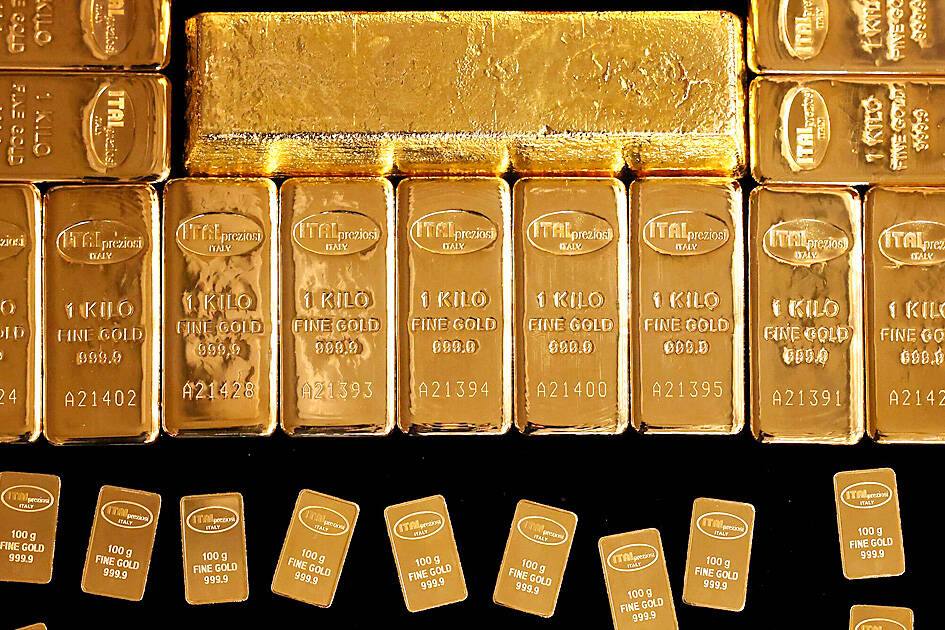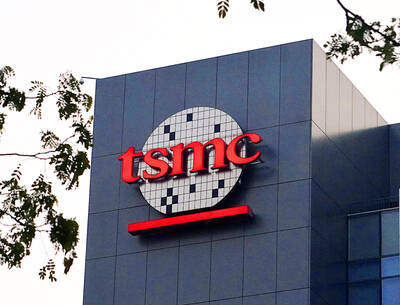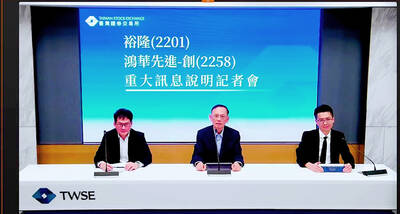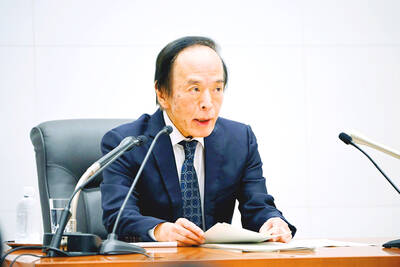A record share of the world’s central banks plans to accumulate more gold over the next 12 months, drawn by bullion’s performance during times of crisis and protection against inflation.
In a survey of 72 monetary authorities, 43 percent said they expected their gold reserves to increase, up from 29 percent a year earlier and the highest figure in eight years of data collected by the World Gold Council (WGC) and YouGov. None anticipated a decline.
Central banks have been one of the most important drivers of a long-running gold rally that has seen prices double since late 2022. The pace of buying doubled after Russia’s invasion of Ukraine in February 2022, when the freezing of much of Russia’s foreign currency holdings highlighted the appeal of bullion as a reserve asset.

Photo: Bloomberg
“There are some pretty big moves in some of these numbers,” said Shaokai Fan (范少凱), global head of central banks for the WGC, a trade body representing gold miners. “Western countries have stopped selling and emerging market countries have started buying, they’re catching up and building more gold reserves.”
The overwhelming majority of respondents said they thought central bank gold reserves would increase globally over the next 12 months, with the most commonly cited factors being its performance during crises, its role as a portfolio diversifier and a store of value.
Central banks have been mopping up more than 1,000 tonnes for each of the last three years, and are set to continue that pace of buying this year, consultancy Metals Focus said.
They have been net buyers for the last 15 years, reversing net sales that drove a decade-long bear market in the 1990s.
The buying helped gold overtake the euro as the second-largest asset in the reserves of the world’s central banks late last year. US dollar assets, mostly Treasuries, extended a steady decline to reach 46 percent of global reserves.
Among the factors that threaten to accelerate the decline of the US dollar’s share of global reserves are the country’s yawning fiscal deficits, confiscation risk and speculation that foreign creditors might be treated less favorably.
All that stands to benefit gold. More than half of the central banks from emerging economies in the survey said that gold’s lack of political risk was a relevant factor behind their decision to hold gold, while 78 percent cited its lack of default risk.
However, the US dollar is not in danger of losing its status as the dominant reserve asset anytime soon.
“Central banks are looking at the dollar and the Treasury market with a little bit more care than they would earlier on, but I don’t think that this is a sort of mad rush for the doors,” Fan said.

Taiwan’s long-term economic competitiveness will hinge not only on national champions like Taiwan Semiconductor Manufacturing Co. (TSMC, 台積電) but also on the widespread adoption of artificial intelligence (AI) and other emerging technologies, a US-based scholar has said. At a lecture in Taipei on Tuesday, Jeffrey Ding, assistant professor of political science at the George Washington University and author of "Technology and the Rise of Great Powers," argued that historical experience shows that general-purpose technologies (GPTs) — such as electricity, computers and now AI — shape long-term economic advantages through their diffusion across the broader economy. "What really matters is not who pioneers

In a high-security Shenzhen laboratory, Chinese scientists have built what Washington has spent years trying to prevent: a prototype of a machine capable of producing the cutting-edge semiconductor chips that power artificial intelligence (AI), smartphones and weapons central to Western military dominance, Reuters has learned. Completed early this year and undergoing testing, the prototype fills nearly an entire factory floor. It was built by a team of former engineers from Dutch semiconductor giant ASML who reverse-engineered the company’s extreme ultraviolet lithography (EUV) machines, according to two people with knowledge of the project. EUV machines sit at the heart of a technological Cold

TAIWAN VALUE CHAIN: Foxtron is to fully own Luxgen following the transaction and it plans to launch a new electric model, the Foxtron Bria, in Taiwan next year Yulon Motor Co (裕隆汽車) yesterday said that its board of directors approved the disposal of its electric vehicle (EV) unit, Luxgen Motor Co (納智捷汽車), to Foxtron Vehicle Technologies Co (鴻華先進) for NT$787.6 million (US$24.98 million). Foxtron, a half-half joint venture between Yulon affiliate Hua-Chuang Automobile Information Technical Center Co (華創車電) and Hon Hai Precision Industry Co (鴻海精密), expects to wrap up the deal in the first quarter of next year. Foxtron would fully own Luxgen following the transaction, including five car distributing companies, outlets and all employees. The deal is subject to the approval of the Fair Trade Commission, Foxtron said. “Foxtron will be

INFLATION CONSIDERATION: The BOJ governor said that it would ‘keep making appropriate decisions’ and would adjust depending on the economy and prices The Bank of Japan (BOJ) yesterday raised its benchmark interest rate to the highest in 30 years and said more increases are in the pipeline if conditions allow, in a sign of growing conviction that it can attain the stable inflation target it has pursued for more than a decade. Bank of Japan Governor Kazuo Ueda’s policy board increased the rate by 0.2 percentage points to 0.75 percent, in a unanimous decision, the bank said in a statement. The central bank cited the rising likelihood of its economic outlook being realized. The rate change was expected by all 50 economists surveyed by Bloomberg. The